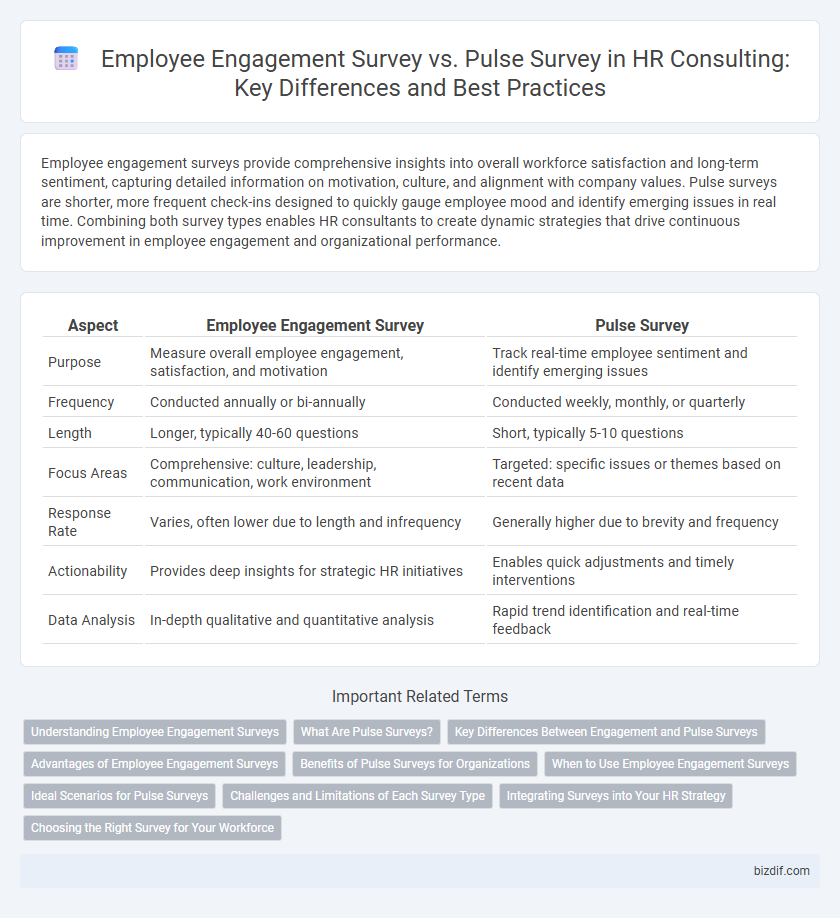Employee engagement surveys provide comprehensive insights into overall workforce satisfaction and long-term sentiment, capturing detailed information on motivation, culture, and alignment with company values. Pulse surveys are shorter, more frequent check-ins designed to quickly gauge employee mood and identify emerging issues in real time. Combining both survey types enables HR consultants to create dynamic strategies that drive continuous improvement in employee engagement and organizational performance.
Table of Comparison
| Aspect | Employee Engagement Survey | Pulse Survey |
|---|---|---|
| Purpose | Measure overall employee engagement, satisfaction, and motivation | Track real-time employee sentiment and identify emerging issues |
| Frequency | Conducted annually or bi-annually | Conducted weekly, monthly, or quarterly |
| Length | Longer, typically 40-60 questions | Short, typically 5-10 questions |
| Focus Areas | Comprehensive: culture, leadership, communication, work environment | Targeted: specific issues or themes based on recent data |
| Response Rate | Varies, often lower due to length and infrequency | Generally higher due to brevity and frequency |
| Actionability | Provides deep insights for strategic HR initiatives | Enables quick adjustments and timely interventions |
| Data Analysis | In-depth qualitative and quantitative analysis | Rapid trend identification and real-time feedback |
Understanding Employee Engagement Surveys
Employee engagement surveys provide comprehensive insights by evaluating multiple dimensions of workplace satisfaction, motivation, and alignment with company values, typically conducted annually. Pulse surveys offer targeted, frequent check-ins that capture real-time employee sentiment and monitor short-term changes in engagement levels. Understanding these tools helps HR professionals tailor strategies for improving organizational culture and enhancing workforce productivity.
What Are Pulse Surveys?
Pulse surveys are short, frequent surveys designed to quickly capture real-time employee feedback, enabling HR teams to monitor engagement, morale, and workplace sentiment continuously. Unlike traditional comprehensive employee engagement surveys conducted annually, pulse surveys provide timely insights that help identify issues early and track the effectiveness of interventions. These concise surveys typically focus on specific themes or questions, facilitating agile and data-driven HR decision-making.
Key Differences Between Engagement and Pulse Surveys
Employee engagement surveys provide comprehensive insights into long-term employee motivation and satisfaction, typically conducted annually to assess workplace culture and organizational commitment. Pulse surveys, in contrast, are short, frequent assessments designed to quickly measure real-time employee sentiment and identify immediate issues. Key differences include survey length, frequency, and depth of data, with engagement surveys offering detailed strategic analysis and pulse surveys delivering rapid feedback for agile decision-making.
Advantages of Employee Engagement Surveys
Employee engagement surveys offer comprehensive insights by capturing detailed feedback from employees across various dimensions such as job satisfaction, workplace culture, and management effectiveness, enabling organizations to identify deep-rooted issues. These surveys typically provide statistically significant data due to their broad scope and longer duration, which supports strategic workforce planning and long-term improvements. By leveraging extensive employee input, companies can develop targeted action plans to enhance retention, boost productivity, and foster a more committed workforce.
Benefits of Pulse Surveys for Organizations
Pulse surveys provide organizations with real-time insights into employee sentiment, enabling rapid identification of issues and timely intervention. These frequent, concise assessments drive continuous engagement improvements and foster a culture of open communication. Using pulse surveys, companies can enhance employee retention, boost productivity, and align workforce priorities more effectively than with traditional annual engagement surveys.
When to Use Employee Engagement Surveys
Employee engagement surveys are most effective when measuring long-term employee satisfaction, culture alignment, and overall workplace morale at regular intervals, typically annually or biannually. Use engagement surveys to gather comprehensive insights on employee motivation, job satisfaction, and commitment, enabling data-driven strategies for improving talent retention and organizational performance. These in-depth surveys are ideal for capturing broad trends and identifying systemic issues that require strategic HR interventions.
Ideal Scenarios for Pulse Surveys
Pulse surveys are ideal for capturing real-time employee feedback during periods of organizational change or after implementing new policies, enabling swift adjustments to improve workplace morale. These short, frequent surveys help HR teams track employee sentiment trends, identify emerging issues quickly, and maintain continuous communication channels. Pulse surveys excel in dynamic environments where timely insights drive proactive engagement strategies and foster a culture of responsiveness.
Challenges and Limitations of Each Survey Type
Employee engagement surveys often face challenges related to lengthy completion times and lower response rates, which can limit the accuracy and timeliness of insights. Pulse surveys, while providing more frequent data, may suffer from survey fatigue and less comprehensive feedback, potentially leading to superficial interpretations. Both survey types require balancing depth of information with respondent engagement to effectively inform HR strategies.
Integrating Surveys into Your HR Strategy
Integrating employee engagement surveys and pulse surveys into your HR strategy provides a comprehensive understanding of workforce sentiment, capturing both in-depth insights and real-time feedback. Engagement surveys offer detailed, periodic data on overall job satisfaction, while pulse surveys deliver frequent snapshots highlighting current morale and emerging issues. Combining these tools enables HR leaders to tailor initiatives effectively, enhance employee experience, and drive continuous organizational improvement.
Choosing the Right Survey for Your Workforce
Selecting the appropriate survey type depends on organizational goals and workforce dynamics; employee engagement surveys provide comprehensive insights into workplace satisfaction and culture, typically conducted annually to guide strategic decisions. Pulse surveys offer more frequent, targeted feedback on specific issues or ongoing initiatives, enabling real-time adjustments to improve employee morale and productivity. Understanding the difference allows HR leaders to align survey frequency and depth with employee needs and organizational priorities, maximizing the impact of feedback-driven actions.
employee engagement survey vs pulse survey Infographic

 bizdif.com
bizdif.com